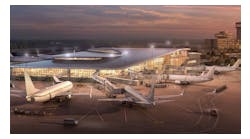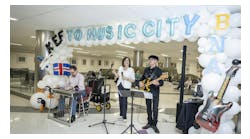Oct. 20—WILLOWS — Thanks to its remarkably rich history for such a small-town facility, the Willows-Glenn County Airport earned a spot on the National Park Service's National Register of Historic Places as of Oct. 6.
According to the National Park Service's website, "All national historic landmarks are included in the National Register of Historic Places, which is the official list of the nation's historical properties worthy of preservation. Landmarks constitute more than 2,500 of more than 90,000 entries in the National Register; the others are of state and local significance."
The airport is a historical district with all current buildings, structures, runways and aprons included in the designation. Those that were present during the historical period of 1928-82 are considered "contributing" to the property's status, while those added after that time are "non-contributing."
"The main reason for inclusion on the National Register is that the airport was the location of the Mendocino Aerial Tanker Squad for the U.S. Forest Service from 1956 until 1982," explained Ted Atlas, a Bay Area historian who has performed significant study on the airport's background.
"It was the first such squad in the United States," he said. "The success of those original pilots, flying open-cockpit biplanes, capable of dropping 120 gallons of water and retardant, was the basis for current state-of-the-art aircraft capable of dropping thousands of gallons in a single load."
The Forest Service moved its operation to Chico in 1982 in order to accommodate aircraft with larger payload capacities.
Among the "contributing" assets at the Willows airport is the 51-foot-tall steel beacon tower, constructed in 1928 when the airport was built as an intermediate landing field along the Contracted Air Mail Route No. 8, from Los Angeles to Seattle. That tower is still in use, though its beacon has been changed over the years.
It is the only 51-foot tower still in use at an original airport in California. There were originally more than 40 airports and intermediate landing fields on various air mail routes in California.
Glenn County recently took steps to protect this tower with a fence. However, it remains out of compliance with FAA standards that state is must be painted alternating sections of "aviation orange" and "aviation white." It is currently painted pink.
"Under the criteria of being listed in the National Register of Historic Places, all of the history of the relevant period is included," Atlas said. "This allowed for the inclusion of the training conducted at the airport by the Doolittle Raiders, just prior to their departure from San Francisco Bay aboard USS Hornet (CV-8) in April 1942" during World War II.
The Raiders conducted the operation in retaliation to the Dec. 7, 1941, Japanese attack on Pearl Harbor. The raid on the Tokyo area didn't cause a great deal of damage, but it dealt a psychological blow to the Japanese as it proved their nation was vulnerable to attack.
U.S. Army Air Force Lt. Col. Jimmy Doolittle often visited the Willows area to hunt with Floyd Nolta, the first manager of the Willows Airport and a pioneer of sowing rice by air. Nolta and Doolittle served together in the Army Signal Corps during World War I.
After training at Elgin Army Field in Florida, the Doolittle Raiders flew to McClellan Field in Sacramento for final maintenance on their North American Aviation B-25B Mitchell bombers. Upon completion of the work at McClellan, the air crews were taken to Willows by Lt. Henry Miller, the U.S. Navy pilot who was assigned to teach them how to conduct the short-field take off procedures they needed to take off from the deck of an aircraft carrier.
After their practice session at Willows, they flew directly to Alameda Naval Air Station where the planes were lifted aboard the ship.
"This story remained local lore for many years," Atlas said. "Official verification was found in the Temporary Duty Report that Lt. Miller filled with his commander upon his return to Pensacola Naval Air Station after accompanying the Raiders on the Hornet and then returning to Pearl Harbor and then back to Florida.
"Miller was a career naval officer and retired as a rear admiral in the 1970s. In an oral history given to the U.S. Naval Institute, he told the story of triaging in Willows," Atlas said. "These documents were provided to me by Bob Fish, the historian of the USS Hornet (CV-12) in Alameda."
Atlas said he discovered even more information to add to the airport's impressive stock of history. It was also the site of an auxiliary field — a support facility for the Chico Army Airfield.
"It was not only used by the pilots undergoing training at Chico Army Field but also pilots at Hamilton Army Field in Marin County," Atlas explained. "As part of the Western Defense Command, pilots at Hamilton trained in (aircraft including) the P-38 Lightning, P-40 Warhawk and P-51 Mustang. It is likely that many of those aircraft were present at the ( Willows) airport during the war."
___
(c)2023 Chico Enterprise-Record, Calif
Visit Chico Enterprise-Record, Calif at www.chicoer.com
Distributed by Tribune Content Agency, LLC.


